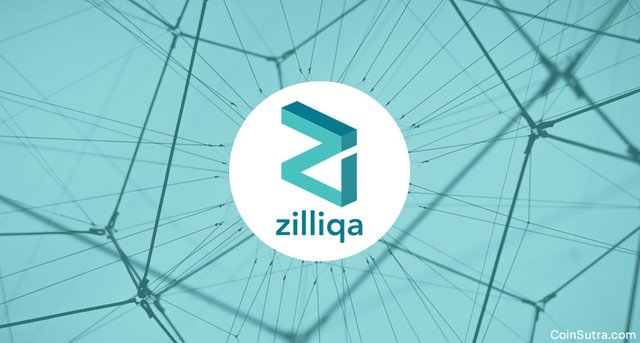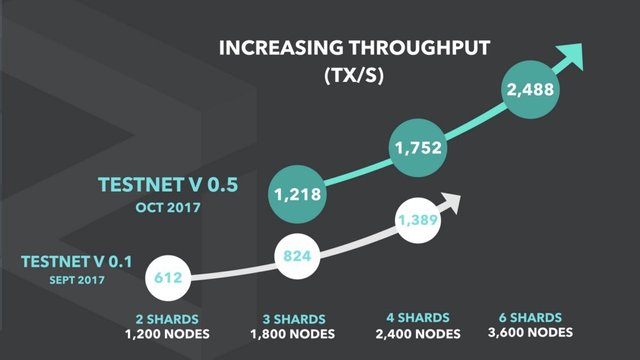Brief
Zilliqa is a cryptocurrency that essentially falls into the payments and platform category. The stand-out feature is it’s through put capability. In simple terms, it has the ability to process a multitude of transactions per second. The project is about 2 years old and was born out of the University of Singapore. It was only after a significant amount of research and trials that they decided to go ahead with an ICO, capped at $22 million. Other significant investments come from NEO Global and FBG Capital. Everything seems quite normal but sets Zilliqa apart from any other platform like Ethereum, Tron, EOS, or Cardano? The simple answer to that; sharding!

Source: CoinSutra
Breakdown
Zilliqa relies on a method of blockchain scaling known as sharding. You might be familiar with the term because Vitalik Buterin often talks about the potential sharding has as a solution to the scalability problem. Sharding is a technique of database segregation that breaks it down into smaller pieces into which information can flow simultaneously. To understand the mechanics of how this works in a blockchain, consider the following example. A block in the blockchain is represented by a glass. The transactions are the water. Now we know the water has to go into the glass. But there are multiple people who want to pour their water into this glass. With a traditional blockchain, the glasses are stacked one on top of the other. The rule is that you have to wait your turn and only pour water into the bottom most glass that is empty. This means till the glass at the bottom is empty, nobody can pour water into the other glasses. So naturally, everybody waiting to pour their water into a glass has to patiently wait for their turn to pour their water. This process is extremely time consuming. With sharding, the glasses are kept one next to the other and instead of each person standing in one long line, there is a line for each glass and people pour their water and are done. Seems much quicker, right? Sharding breaks a database into pieces which are filled and then attached to the other shards on the main chain. It significantly reduces the time for each transaction and creates an efficient ecosystem with low fees and waiting times.
Use Case
Zilliqa ran a test run in late 2017, they ran 3600 nodes on the network and reached a maximum throughput of 2488 tx per second. That is remarkable speed for a blockchain, even faster than Stellar Lumes (1000-1500) and close to Ripple (2500-3000). The best part about this is that it isn’t a uniquely payment based protocol; their objective is to be a platform to develop and run dApp’s or ‘decentralized applications’. dApps that exist today mostly run on Ethereum and EOS. But both of these platforms are currently unsuitable for large scale decentralized apps. Ethereum has an average throughput of 15 tx per second. This makes it incredibly inefficient to even run an application with 10000-15000 people. A detailed study by ‘Whiteblock’, a blockchain research lab, showed that EOS may actually be centralized as DPoS is not an ideal consensus mechanism and there are many additional flaws they found upon creating a replica of the network (more in detail at a later time). So none of these major platforms currently offer any real potential to run decentralized applications. Even with the Casper implementation, Ethereum’s throughput is estimated to be around 75 tx per second.

Source: Hackernoon
Considering all this, Zilliqa promises to be an application platform that can actually sustain the amount of transactions required to run multiple ecosystems as a layer over the blockchain. It uses a dual consensus mechanism in order to add an extra layer of efficiency (mostly related to not having constant Proof of Work). It has the throughput of a high frequency payment protocol like Stellar Lumens as well as the capability to act as bottom layer to a particular network like Ethereum.
Details of the Network
Zilliqa uses Proof of Work and Byzantine Fault Tolerance side by side. This provides them an order of extra security as BFT operates on the hostile assumption that a node may be Byzantine. In order for a miner to get accepted by the network, they have to perform a Proof of Work. After this is confirmed, they are assigned to a shard along with other nodes. The nodes on a shard can see each other on the network. The minimum amount of miners in a shard has a lower bound of 600 and currently has no upper bound. The need for the lower bound is to decrease the probability of an attack on the network as 1/3rdof the nodes have to be malicious to do so. The probability is significantly reduce if 200/600 nodes must be malicious. The upper bound is not set so that the network doesn’t bottleneck and saturate in throughput like a normal blockchain. The key element of Zilliqa is their transaction speed so it makes sense for them to not have an upper bound for the time being.
As of the test net, block times are to be 2 minutes. The problem of storage doesn’t arise if you remove the element of smart contracts from the equation. Practically, smart contracts are an essential part of the Zilliqa chain so the team must be in contact with decentralized storage projects to address this issue. It should be noted that the mining in not constant Proof of Work. After the initial Proof of Work, transactions are confirmed through Byzantine Fault Tolerance. After every specified number of blocks, the node would have to do a Proof of Work again in order to stay on the network. The exact number is unknown but the whitepaper has guided around 60 blocks as of now.
Zilliqa recognizes a node based on network address, so in the event a miner has extra power, they may not be able to utilize it on the Zilliqa blockchain unless they have another port through which they can use a different network address. Zilliqa is also making their own language for smart contract operability. Unlike Solidity, Zilliqa will not be a Turing complete language. Simply put, the language cannot be used to program just anything, it will be used specifically to write smart contracts on the Zilliqa network. The option of mutable smart contracts is something the developers are pondering over.
Key Takeaways
· Zilliqa implements transactional sharding and not state sharding. State sharding is what the Ethereum developers are working towards and hasn’t been proven or developed yet. Transactional sharding is fully operational (only on Zilliqa so far).
· Short block time so the pool of transactions doesn’t pile up.
· Miners need to wait their turn in order to get rewards from mining their shard, but this also means that once they join a shard their reward is practically guaranteed. The round robin reward system is one of my favorite aspects of Zilliqa.
· The biggest problem is that if the network gets too large and data has to be broadcasted over a multitude of nodes, the time per transactions will suffer and ultimately slow down the network. If this happens, I can see each shard having an upper bound to the number of nodes as well. The development team have also guided that in the situation of this occurring they will explore their options to implement something similar to the emergency difficulty adjustment like on Bitcoin Cash.
Conclusion
Zilliqa was extremely hyped up while it was raising money through its ICO. This led a lot of people to believe that the project was just another ‘get rich quick’ scheme. But with hard evidence and real trials and results, Zilliqa has proven itself as a real contender in the space, being able to sustain transactions unlike any other dApp platform. The project will launch its main net on 31 January 2019 while mining capabilities are already launched. Their focus on implementing transactional sharding and not trying to find a solution to state sharding has led them to become one of the fastest chains in the cryptocurrency space. Eventually, state sharding will find a solution that renders it feasible, but till then, Zilliqa’s sharding is the best bet blockchain has for real scalability.
Information Sources
· Mega FAQ
· Jimmy Song on BCH Emergency Difficulty
- AB
-----
ReverseAcid Monthly Recap
-----
Crypto Analysis Series
- Part 1 - Basic Attention Token and How It's Revolutionizing the Internet
- Part 2 - Golem Network Token as a Potential Giant Killer
- Part 3 - Augur and the Future of Decentralized Predictions Markets
- Part 4 - Dogecoin - Such Meme, Much Value
-----
Previous posts:
- Governmental Incentives for Implementing Distributed Databases
- Current Scenario of the Global Stock Market: A Detailed View Into Major World Indices
- Giving in to Your Fear: Does the Current Market Warrant this Magnitude of FUD?
- DLT, Blockchain, and Cryptocurrencies: What it all Means for FinTech and More
- Confidence Crisis: HODL on to Your Horses
- Bitcoin Technicals: In Depth Breakdown of the Current Move
- The Scalability Trilemma
- Online Retailer’s Incentives for using cryptocurrencies as a medium of exchange
-----
About Reverse Acid
-----
Be a part of our Discord community to engage in related topic conversation.

-----
Follow our Instagram page for timely market updates

Thank you for using Resteem & Voting Bot @allaz Your post will be min. 10+ resteemed with over 13000+ followers & min. 25+ Upvote Different account (5000+ Steem Power).
Downvoting a post can decrease pending rewards and make it less visible. Common reasons:
Submit
Thank you, for appreciating Osho video and sending me some thing..I don't understand this system of voting and giving-getting some rewards. But wish you all the best!
Downvoting a post can decrease pending rewards and make it less visible. Common reasons:
Submit
Very informative, i really like the Zilliqa project. nice read
Downvoting a post can decrease pending rewards and make it less visible. Common reasons:
Submit